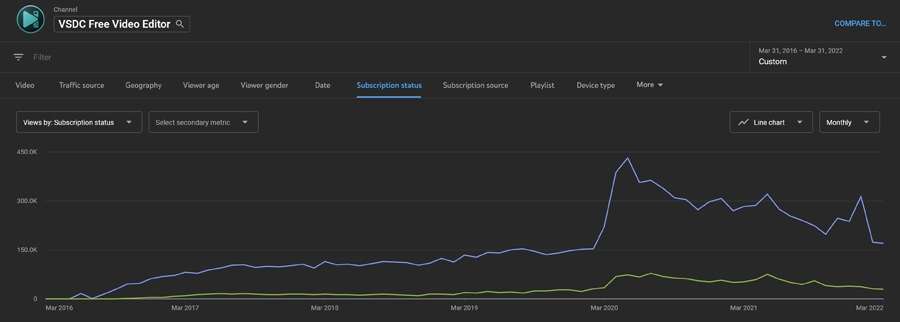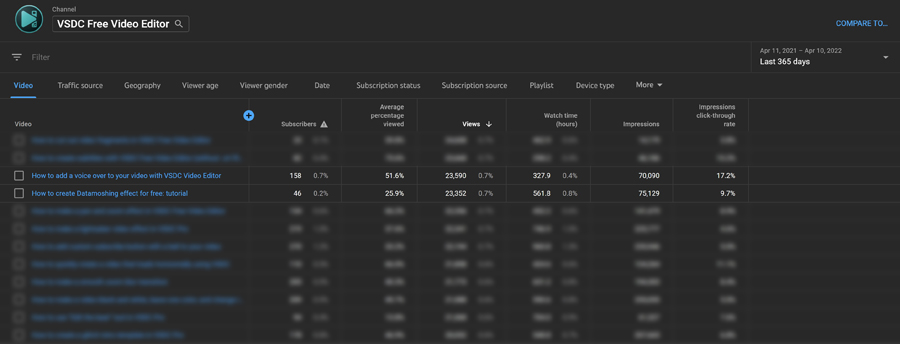VSDC Celebrates 100K Subscribers on YouTube
Last week, we received the long-awaited silver button from YouTube for reaching 100K subscribers.
The button arrived in a neat black box, along with a letter of encouragement from the YouTube team. For us, it’s an exciting moment, and judging by the comments on our channel, we have the best, most empathetic audience to share it with.
As creators who have reached their first big milestone, we decided to share some of the lessons we’ve learned during this journey.
You can read them below.
It’s okay not to get things right the first time
Our growth journey has never been straightforward. For a small team with zero experience in video marketing, it was a steep learning curve. For example, although the VSDC’s channel is almost 8 years old, it’s the last 3 years that have made the biggest impact on its growth. During that period, we jumped from 23K to 100K subscribers.
Before we got to those 23K, there had been a long way of trial and error.
If you ever decide to scroll all the way down our channel uploads, you’ll notice that we’ve dramatically changed our approach to YouTube videos several times. For example, during the first few years, we used the channel to educate users about specific features and settings using short, technical videos, often with no intro or narration. The channel was an extension of our Help center, not a marketing tool. Today, we use the channel to both educate current VSDC users and attract new creators looking for a specific solution or guidance.
As we switched from single-feature-centered tutorials, our workflow has also changed. Here are the three steps we take each time when we want to post a new video:
- Research – that’s when we look and search queries, trends, and comments
- Production – that’s when we record a video and put it together with the voiceover
- Optimization – that’s when we craft the copy, thumbnail, end screen, and other elements
Overnight success doesn’t exist. But if you continuously test new hypotheses, ask your audience for feedback, and use analytics tools, you’ll inevitably figure things out. However (here comes a spoiler) even when you do, you should still be ready for numerous ups and downs. That brings us to the next lesson.
Growing a channel is a rollercoaster
Way too many factors are involved in a channel’s success. The biggest ones are often out of your control: search trends, algorithms, and global events.
For example, we saw a huge spike in views and subscriptions at the beginning of the pandemic.

This is easy to explain: people stayed home, spent more time on YouTube, and many returned to their hobbies — video editing being one of them.
The year 2021 (that’s when many countries started lifting the stay-at-home mandate) was visibly less successful for the channel, despite us pouring the same amount of effort into it. Seeing a drop in subscribers growth was upsetting, but it was something out of our control.
As a creator, it’s important that you learn to spot anomalies in your channel’s performance and tell whether they are the result of your actions or one of those outside factors.
That being said, it’s also crucial to focus on the factors you can control. Here are some of them:
- Consistency – set a publishing schedule and stick to it
- Video structure – use the “PPP formula" described by Brian Dean
- Engagement – ask questions, use calls to action, and always, always respond to comments
Each of these factors affects different metrics that influence your overall channel performance. For example, consistency is believed to be a good SEO signal for YouTube. A clear and cohesive video structure helps increase video retention. Engagement helps you build relationships with your audience and discover content ideas.
YouTube analytics is an underused tool that has plenty of answers
Every creator knows that YouTube provides access to detailed performance reports. However, some creators tend to focus on vanity metrics, such as the overall number of views and subscribers.
A large number of views and subscribers have little value if people stop watching your videos after a few seconds, and the comments section is empty.
That’s why it’s essential to look at other metrics, such as:
- Impression click-through rate (CTR) – helps quickly evaluate your thumbnail and copy
- Average percentage viewed – shows for how long your video can hold the viewer’s attention
- Subscribers gained – identifies which videos drive subscribers to your channel
Notice how the two videos in the screenshot below have almost the same number of impressions and views. However, if you look at the CTR, percentage viewed, and the number of subscribers each video gained, you’ll see that the second video is hugely underperforming.

Understanding your channel’s and each video’s performance will help you spot trends (both positive and negative) and optimize your content creation strategy.
For example, in the past three years, our 5 best-performing videos are:
- How to create an amazing title intro (317K views)
- Getting started with VSDC (234K views)
- How to cut and split a video in VSDC (223K views)
- How to make a green screen (163K views)
- How to make any video look cinematic (137K views)
These videos don’t just bring lots of new subscribers — they also have high retention rates. Of course, for you, success metrics may be different.
Now, when is the next milestone?
Now that we’ve reached 100K subscribers, we’re on to the next milestone. SocialBlade, an analytics platform for YouTube channels, predicts our channel will reach 200K subscribers in 2027. Let’s speed things up together!